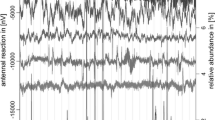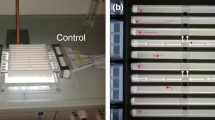Abstract
Methyl salicylate (MeSA) is a commonly emitted herbivore-induced plant volatile (HIPV) known to attract insect predators in agricultural crops. However, thorough studies on whether MeSA can increase their ecological functioning or their attraction under field conditions are still lacking. Here, we conducted laboratory, greenhouse, and field studies to address the hypothesis that two agriculturally important predatory insects (the ladybeetle Hippodamia convergens Guérin-Méneville and the lacewing Chrysoperla rufilabris Burmeister) respond physiologically and behaviorally to MeSA, which may lead to increased predation and oviposition. In laboratory studies using electro-antennography, we found that male and female H. convergens and C. rufilabris antennae can detect MeSA; however, for both species, female antennae responded more strongly. In greenhouse studies using cages and wind tunnels, H. convergens females were attracted to, and arrested by, MeSA; this attraction increased egg predation. Attraction of C. rufilabris females to MeSA also increased oviposition. In field studies, mark-release-recapture experiments were performed to investigate H. convergens and C. rufilabris attraction to MeSA over various distances in cranberry fields. More H. convergens and C. rufilabris were caught on yellow sticky cards placed close (0–30 m) to the predator release site than at farther distances, regardless of whether the cards were baited with MeSA or not. In conclusion, H. convergens and C. rufilabris adults detected, and were attracted to, MeSA under laboratory and greenhouse conditions, resulting in higher predation and oviposition, but this attraction was not observed under field conditions. These results demonstrate that predator responses to HIPVs can be complex in real agricultural settings.




Similar content being viewed by others
References
Aldrich JR, Zhang QH (2016) Chemical ecology of neuroptera. Ann Rev Entomol 61:197–218
Azandémè-Hounmalon GY, Torto B, Fiaboe KKM, Subramanian S, Kreiter S, Martin T (2016) Visual, vibratory, and olfactory cues affect interactions between the red spider mite Tetranychus evansi and its predator Phytoseiulus longipes. J Pest Sci 89:137–152
Blaauw BR, Jones VP, Nielsen AL (2016) Utilizing immunomarking techniques to track Halyomorpha halys (Hemiptera: Pentatomidae) movement and distribution within a peach orchard. PeerJ 4:e1997
Blande JD, Korjus M, Holopainen JK (2010) Foliar methyl salicylate emissions indicate prolonged aphid infestation on silver birch and black alder. Tree Physiol 30:404–416
Braasch J, Wimp GM, Kaplan I (2012) Testing for phytochemical synergism: arthropod community responses to induced plant volatile blends across crops. J Chem Ecol 38:1264–1275
Carvalho CF, Souza B (2009) Métodos de criação e produção de crisopídeos. In: Bueno VHP (eds) Controle biológico de pragas: produção massal e controle de qualidade. UFLA, Lavras, pp 77–115.
De Boer JG, Dicke M (2004) The role of methyl salicylate in prey searching behavior of the predatory mite Phytoseiulus persimilis. J Chem Ecol 30:255–271
Dicke M, Sabelis MW, Takabayashi J, Bruin J, Posthumus MA (1990) Plant strategies of manipulating predator-prey interactions through allelochemicals: prospects for application in pest control. J Chem Ecol 16:3091–3118
Dicke M, van Loon JJA (2000) Multitrophic effects of herbivore-induced plant volatiles in an evolutionary context. Entomol Exp Appl 97:237–249.
Drukker B, Bruin J, Sabelis MW (2000) Anthocorid predators learn to associate herbivore-induced volatiles with presence or absence of prey. Physiol Entomol 25:260–265.
Fréchette B, Coderre D, Lucas E (2006) Chrysoperla rufilabris (Neuroptera: Chrysopidae) females do not avoid ovipositing in the presence of conspecific eggs. Biol Control 37:354–358
Gadino AN, Walton VM, Lee JC (2012a) Evaluation of methyl salicylate lures on populations of Typhlodromus pyri (Acari: Phytoseiidae) and other natural enemies in western Oregon vineyards. Biol Control 63:48–55
Gadino AN, Walton VM, Lee JC (2012b) Olfactory response of Typhlodromus pyri (Acari: Phytoseiidae) to synthetic methyl salicylate in laboratory bioassays. J Appl Entomol 136:476–480
Hagler JR, Jones VP (2010) A protein-based approach to mark arthropods for mark-capture type research. Entomol Exp Appl 135:177–192.
Hagler JR, Baker PB, Marchosky R, Machtley SA, Bellamy DE (2009) Methods to mark termites with protein for mark-release-recapture and mark-capture type studies. Insect Soc 56:213–220
Hagler JR, Naranjo SE, Machtley SA, Blackmer F (2014) Development of a standardized protein immunomarking protocol for insect mark-capture dispersal research. J Appl Entomol 138:772–782
Hegde M, Oliveira JN, Costa JG, Bleicher E, Santana EG, Bruce JA, Caulfield J, Dewhirst SY, Woodcock CM, Pickett JA, Birkett MA (2011) Identification of semiochemicals released by cotton, Gossypium hirsutum, upon infestation by the cotton aphid, Aphis gossypii. J Chem Ecol 37:741–750
James DG (2003) Field evaluation of herbivore-induced plant volatiles as attractants for beneficial insects: methyl salicylate and the green lacewing, Chrysopa nigricornis. J Chem Ecol 29:1601–1609
James D (2006) Methyl salicylate is a field attractant for the goldeneyed lacewing, Chrysopa oculata. Biocontrol Sci Technol 16:107–110.
James DG, Grasswitz TR (2005) Synthetic herbivore-induced plant volatiles increase field captures of parasitic wasps. Biocontrol 50:871–880
James DG, Price TS (2004) Field-testing of methyl salicylate for recruitment and retention of beneficial insects in grapes and hops. J Chem Ecol 30:1613–1628
Jones VP, Steffan SA, Wiman NG, Horton DR, Miliczky E, Zhang QH, Baker CC (2011) Evaluation of herbivore-induced plant volatiles for monitoring green lacewings in Washington apple orchards. Biol Control 56:98–105
Kelly JL, Hagler JR, Kaplan I (2014) Semiochemical lures reduce emigration and enhance pest control services in open-field predator augmentation. Biol Control 71:70–77
Kindlmann P, Dixon AFG (1993) Optimal foraging in ladybird beetles (Coleoptera, Coccinellidae) and its consequences for their use in biological control. Eur J Entomol 90:443–450.
Kunkel BA, Cottrell TE (2007) Oviposition response of green lacewings (Neuroptera: Chrysopidae) to aphids (Hemiptera: Aphididae) and potential attractants on pecan. Environ Entomol 36:577–583
Lee JC (2010) Effect of methyl salicylate-based lures on beneficial and pest arthropods in strawberry. Environ Entomol 39:653–660
Mallinger RE, Hogg DB, Gratton C (2011) Methyl salicylate attracts natural enemies and reduces populations of soybean aphids (Hemiptera: Aphididae) in soybean agroecosystems. J Econ Entomol 104:115–124
Melo Machado RC, Sant’Ana J, Blassioli-Moraes MC, Laumann RA, Borges M (2014) Herbivory-induced plant volatiles from Oryza sativa and their influence on chemotaxis behaviour of Tibraca limbativentris stal. (Hemiptera: Pentatomidae) and egg parasitoids. Bull Entomol Res 104:347–356
Musser FR, Shelton AM (2003) Predation of Ostrinia nubilalis (Lepidoptera: Crambidae) eggs in sweet corn by generalist predators and the impact of alternative foods. Environ Entomol 32:1131–1138
Obrycki JJ, Harwood JD, Kring TJ, O’Neil RJ (2009) Aphidophagy by Coccinellidae: application of biological control in agroecosystems. Biol Control 51:244–254
Petersen MK, Hunter MS (2002) Ovipositional preference and larval-early adult performance of two generalist lacewing predators of aphids in pecans. Biol Control 25:101–109
Petersson J, Pickett JA, Pye BJ, Quiroz A, Smart LE, Wadhams LJ, Woodcock CM (1994) Winter host component reduces colonization by bird-cherry-oat aphid, Rhopalosiphum padi (L.) (Homoptera, Aphididae), and other aphids in cereal fields. J Chem Ecol 20:2565–2574
Principi MM, Canard M (1984) Feeding habits. In: Canard M, Séméria Y, New TR (eds) Biology of Chrysopidae. Junk Publishers, The Hague, pp 76–92
R Development Core Team (2015) R: a language and environment for statistical computing. R Foundation for Statiscal Computing. Vienna
Richman DB, Hemenway RC Jr, Whitcomb WH (1980) Field cage evaluation of predators of the soybean looper, Pseudoplusia includens (Lepidoptera: Noctuidae). Environ Entomol 9:315–317
Rodriguez-Saona C, Poland TM, Miller JR, Stelinski LL, Grant GG, de Groot P, Buchan L, MacDonald L (2006) Behavioral and electrophysiological responses of the emerald ash borer, Agrilus planipennis, to induced volatiles of Manchurian ash, Fraxinus mandshurica. Chemoecology 16:75–86
Rodriguez-Saona C, Rodriguez-Saona LE, Frost CJ (2009) Herbivore-induced volatiles in the perennial shrub, Vaccinium corymbosum, and their role in inter-branch signaling. J Chem Ecol 35:163–175
Rodriguez-Saona C, Kaplan I, Braasch J, Chinnasamy D, Williams L (2011a) Field responses of predaceous arthropods to methyl salicylate: A meta-analysis and case study in cranberries. Biol Control 59:294–303
Rodriguez-Saona C, Parra L, Quiroz A, Isaacs R (2011b) Variation in highbush blueberry floral volatile profiles as a function of pollination status, cultivar, time of day and flower part: implications for flower visitation by bees. Ann Bot 107:1377–1390
Salamanca J, Pareja M, Rodriguez-Saona C, Resende ALS, Souza B (2015) Behavioral responses of adult lacewings, Chrysoperla externa, to a rose-aphid-coriander complex. Biol Control 80:103–112
Shapiro SS, Wilk MB (1965) An Analysis of variance test for normality (complete samples). Biometrika 52:591–611
Stelinski LL, Gut LJ, Miller JR (2003) Concentration of air-borne pheromone required for long-lasting peripheral adaptation in the obliquebanded leafroller, Choristoneura rosaceana. Physiol Entomol 28:97–107
Sznajder B, Sabelis MW, Egas M (2010) Response of predatory mites to a herbivore-induced plant volatile: Genetic variation for context-dependent behaviour. J Chem Ecol 36:680–688
Vet LEM, Dicke M (1992) Ecology of infochemical use by natural enemies in a tritrophic context. Ann Rev Entomol 37:141–172
Wang G, Cui LL, Dong J, Francis F, Liu Y, Tooker J (2011) Combining intercropping with semiochemical releases: Optimization of alternative control of Sitobion avenae in wheat crops in china. Entomol Exp Appl 140:189–195.
Weber DC, Lundgren JG (2009) Assessing the trophic ecology of the Coccinellidae: their roles as predators and as prey. Biol Control 51:199–214
Woods JL, James DG, Lee JC, Gent DH (2011) Evaluation of airborne methyl salicylate for improved conservation biological control of two-spotted spider mite and hop aphid in Oregon hop yards. Exp Appl Acarol 55:401–416
Xu X, Cai X, Bian L, Luo Z, Xin Z, Chen Z (2015) Electrophysiological and behavioral responses of Chrysopa phyllochroma (Neuroptera: Chrysopidae) to plant volatiles. Environ Entomol 44:1425–1433
Zhu J, Park KC (2005) Methyl salicylate, a soybean aphid-induced plant volatile attractive to the predator Coccinella septempunctata. J Chem Ecol 31:1733–1746
Zhu J, Obrycki JJ, Ochieng SA, Baker TC, Pickett JA, Smiley D (2005) Attraction of two lacewing species to volatiles produced by host plants and aphid prey. Naturwissenschaften 92:277–281
Acknowledgements
We thank Brett Blaauw and Robert Holdcraft for assistance with the ELISA tests. We also thank Diego Fraga, Kris Dahl, Charles Corris, Gabrielle Pintauro, Manuel Chacón-Fuentes, Mara Schiffhauer, Mike Scullion, Andrew Lux, Caryn Michel, Nakorn Pradit, Andrea Wanumen, and Fernando Sanchez for their help in the field. Thanks to Drs. Elvira de Lange, Maria Fernanda Peñaflor, Rosangela Marucci, Mauricio Simões Bento, Diego Felisbino Fraga, and two anonymous reviewers for providing helpful editorial comments on an earlier draft. Thanks to Pine Island Cranberry Co. Inc. and Pine Barrens Native Fruits, LLC for providing cranberry fields for this study. Funding for this work was provided by a postgraduate grant from the Conselho Nacional de Desenvolvimento Científico e Tecnológico (CNPq) to J.S., and hatch funds (project # NJ08192) to C.R-S.
Author information
Authors and Affiliations
Corresponding author
Additional information
Communicated by as Michael Heethoff.
Rights and permissions
About this article
Cite this article
Salamanca, J., Souza, B., Lundgren, J.G. et al. From laboratory to field: electro-antennographic and behavioral responsiveness of two insect predators to methyl salicylate. Chemoecology 27, 51–63 (2017). https://doi.org/10.1007/s00049-017-0230-8
Received:
Accepted:
Published:
Issue Date:
DOI: https://doi.org/10.1007/s00049-017-0230-8




